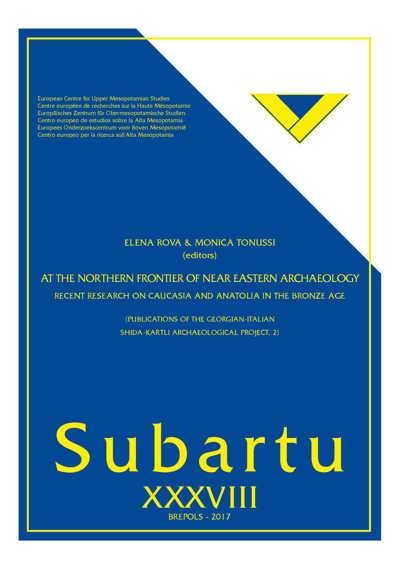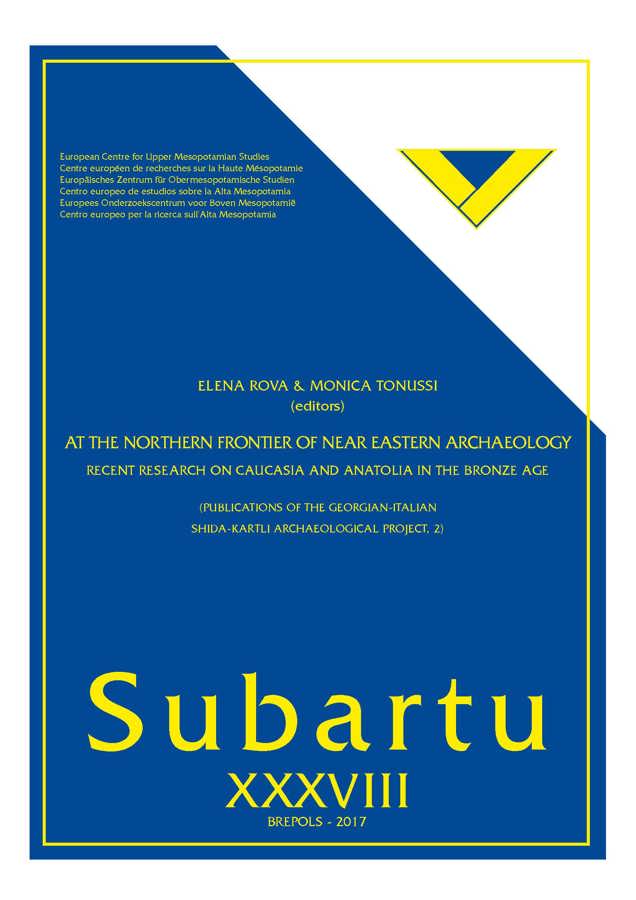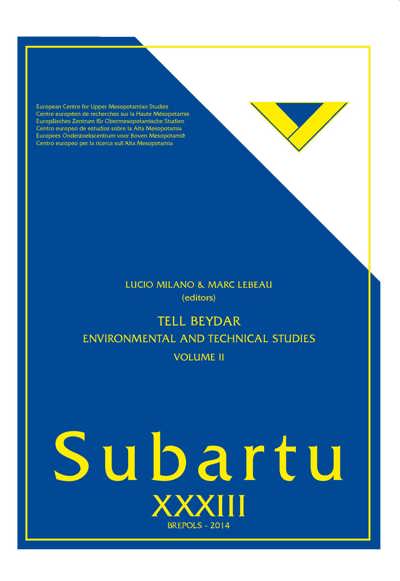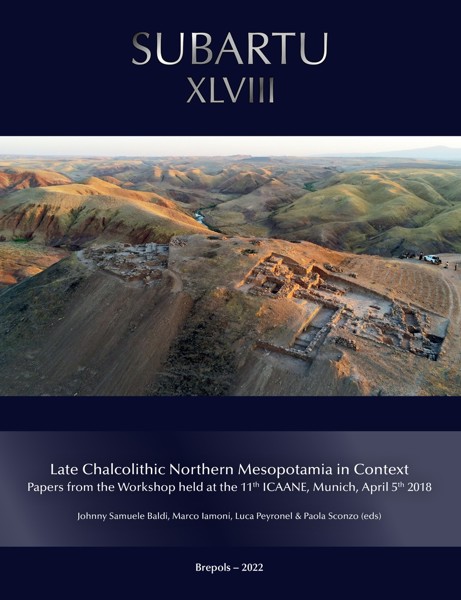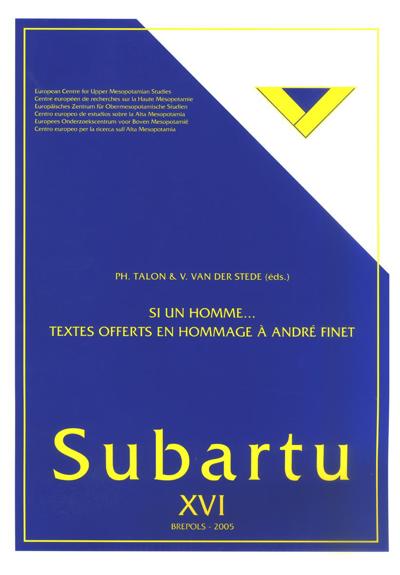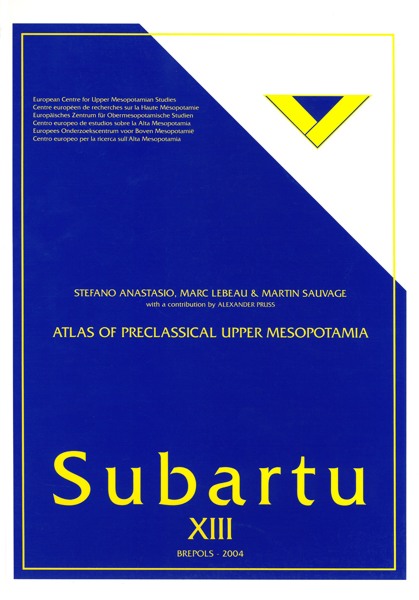
At the Northern Frontier of Near Eastern Archaeology: Recent Research on Caucasia and Anatolia in the Bronze Age/An der Nordgrenze der vorderasiatischen Archäologie: Neue Forschung über Kaukasien und Anatolien in der Bronzezeit
(Publications of the Georgian-Italian Shida-Kartli Archaeological Project, 2)
Elena Rova, Monica Tonussi (eds)
- Pages: viii + 587 p.
- Size:210 x 295 mm
- Illustrations:230 b/w
- Language(s):English, German
- Publication Year:2017
- € 135,00 EXCL. VAT RETAIL PRICE
- ISBN: 978-2-503-54897-5
- Paperback
- Available
“(…) the editors have done an excellent job in bringing the group of researchers together – first during the 2013 meeting in Venice, then as contributors to the edited volume. Anyone dealing with Caucasian archaeology will be thankful for this extensive volume.” (Alexander E. Sollee, in Bibliotheca Orientalis LXXVIII 5/6, 2021, p. 763)
Elena Rova is professor of "Near Eastern Archaeology and Art History" at Ca' Foscari University of Venice. Her main research field is the archaeology of Upper Mesopotamia and the neighbouring areas (Anatolia, Southern Caucasus) in the 4th and 3rd millennium BC. She is co-director of the "Georgian-Italian Shida Kartli Archaeological project".
Monica Tonussi is post-doctoral research fellow at Ca' Foscari University of Venice. She is a specialist of the 3rd millennium BC civilisations of Upper Mesopotamia, Anatolia and Southern Caucasus, with a special focus on ancient metallurgy.
35 papers, originally presented by an international group of researchers at a conference held in Venice in January 2013, present the results of the last 20 years of archaeological research about the pre-classical cultures of the Caucasus and Anatolia, and analyse the latter in the wider framework of their changing relations with those of the Ancient Near East and of the Eurasian steppes. The volume covers a wide chronological span - from the late 5th to the early 1st millennium BC, and includes contributions about a wide range of topics (reports of archaeological excavations and surveys, chronology, economy, social organisation of the ancient populations, technology, long-distance exchange of raw materials and artefacts, archaeometallurgy, landscape archaeology, etc.). According to the most recent developments of research, these are investigated in a remarkably interdisciplinary perspective. The participation to the conference of well-recognised experts working not only in different countries of the Southern Caucasus and in Anatolia (in present-day Georgia, Armenia, Azerbaijan, and Turkey) but also in the North-Caucasian republics of the present-day Russian Federation offered a rare opportunity to compare and discuss recent trends of archaeological research in these different regions. Therefore, this volume represents a fundamental contribution to both Near Eastern and Caucasian Archaeology.
Elena Rova, Monica Tonussi, Editors' preface
Section I. The Late Chalcolithic and the Early Bronze Age
Andrej Belinskij, Svend Hansen & Sabine Reinhold, The Great Kurgan from Nalčik. A Preliminary Report
Sergey N. Korenevskiy, Military and Elite Symbolism in the Funeral Practices of the Maikop-Novosvobodnaia Community
Alexey Rezepkin, The Influence of the Near East on the Formation of the Early Bronze Age in the Northern Caucasus
Barbara Helwing, Networks of Craft Production and Material Distribution in the Chalcolithic: Metallurgical Evidence from Iran and the Southern Caucasus
Judith Thomalsky, Large Blade Technologies in the Southern Caucasus and in Northern Mesopotamia in the 6th-4th millennia BC
Georgi Leon Kavtaradze, An Attempt at Dating the Starting Point of the Kura-Araxes Culture on the Background of the 'Uruk Cultural Phenomenon'
Giulio Palumbi, Push or Pull Factors? The Kura-Araxes 'Expansion' from a Different Perspective: the Upper Euphrates Valley
Monica Tonussi, Salt in the Economic System of Early Transcaucasian Culture. New Perspectives in the Interpretation of the Migration Theory in the Southern Levant
Elena Rova, Zurab Makharadze & Marina Puturidze, Khashuri Natsargora: New Research on the Kura-Araxes and Bedeni Cultures in Central Georgia
Eleonora Carminati, The Martqopi and Bedeni Components of the Early Kurgan Complex in the Shida Kartli (Georgia): A Reappraisal of the Available Data
Winfried Orthmann, Burial Mounds of the Martqopi and Bedeni Cultures in Eastern Georgia
Section II. The Middle and the Late Bronze Age
Stephan Kroll, Early to Middle Bronze Age Transition in the Urmia Basin
Marina Puturidze, On the Origins and Development of Gold Working in the Middle Bronze Age Trialeti Culture
Gian-Maria Di Nocera, Die Mittelbronzezeit am oberen Euphrat: Siedlungscharakter und kulturelle Identität
Armağan Erkanal-Öktü, Panaztepe in der Spätbronzezeit: Eine Studie über die materielle Kultur im mittleren West-Anatolien
Stefania Mazzoni, Uşaklı Höyük and the Bronze Age of Central Anatolia
Elena Devecchi, The Eastern Frontier of the Hittite Empire
Aynur Özfirat, The Late Bronze - Early Iron Age - Urartu Complex at Bozkurt on the Southern Slope of Mt. Ağrı
Martina Babetto & Katia Gavagnin, Late Bronze/Early Iron Age Pottery from Natsargora, Khashuri Region (Georgia): A Preliminary Overview
Sabina Brodbeck-Jucker, Die Keramik von Udabno I als Anhaltspunkt für die Datierung der figürlich verzierten Bronzegürtel in Ostgeorgien
Sabine Reinhold, Late Bronze Age Architecture in Caucasia and Beyond: Building a New Lifestyle for a New Epoch
Section III. Iron Age Developments
Ayşe Tuba Ökse, Transition from Sedentary Farming to Nomadic and Transhumant Pastoralism in the Iron Age: A View from the Upper Tigris Region
Manuel Castelluccia, The Talesh Region in the Iron Age and its Relations with Transcaucasia
Arianna Zischow, South Caucasian Bronze Belts in Context
Mirjo Salvini, Aufstieg und Fall des Reiches Urartu
Claudia Antonetti, Greek Colonisation in the Black Sea: Reflections on Recent Research and Methodological Trends
Attilio Mastrocinque, The Caucasus in the Geographic and Cosmological Conceptions of the Greeks in the Archaic Period
Silvia Palazzo, Kingship between East and West in the Mithridates Eupator
Section IV. Metallurgy and Circulation of Metal Ore and Metal Objects
Evgeni N. Chernykh,
Mikheil Abramishvili, Southern Caucasia in the Near Eastern Bronze Age Economic System
Arsen Bobokhyan, René Kunze, Khachatur Meliksetian & Ernst Pernicka, Society and Metal in Bronze Age Armenia
Antoine Courcier, Maise Ragimova, Netjaf Museibli & Bakhtiyar Jalilova, Metallurgical Developments in Azerbaijan from the Neolithic to the Early Bronze Age: Recent Archaeometallurgical Research in the Middle Kura River valley
Zviad Sherazadishvili, Technical and Typological Improvements and Innovations in Bronze Weapons in the Southern Caucasus: (From the 3rd to the First Half of the 2nd Millennium BC)
David Kuparadze, Dimitri Pataridze, Elena Rova, Mamuka Kapianidze, Gotcha Lagidze & Zaqro Nonikashvili, The Development of Mining, Metallurgy and the Production of Cold Steel Arms in Georgia: A Geological and Archaeological Review
